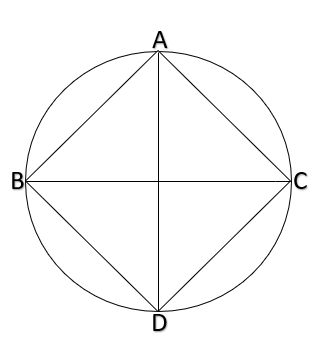
All the vertices of a rhombus lie on a circle. Find the area of the rhombus, if the area of the circle is 1256


Answer
437.7k+ views
Hint:Vertices of cyclic quadrilateral lie on a circle and for cyclic quadrilateral, sum of opposite angles is equal to
Complete step-by-step answer:
Since it is given rhombus is a cyclic quadrilateral.
Let
Sum of opposite angles =
Also AB || CD
Now, as adjacent angles are equal, it is a square.
AC and BD are diameter of circle.
Now, Area of circle = 1256
Diameter of circle = 2r = 40cm
Note: A cyclic quadrilateral or inscribed quadrilateral is a quadrilateral whose vertices all lie on a single circle. This circle is called the circumcircle or circumscribed circle, and the vertices are said to be concyclic. Students must remember the formula for the area of some common geometrical figure such as circle and rhombus.
Complete step-by-step answer:
Since it is given rhombus is a cyclic quadrilateral.
Let
Sum of opposite angles =
Also AB || CD
Now, as adjacent angles are equal, it is a square.
AC and BD are diameter of circle.
Now, Area of circle = 1256
Diameter of circle = 2r = 40cm
Note: A cyclic quadrilateral or inscribed quadrilateral is a quadrilateral whose vertices all lie on a single circle. This circle is called the circumcircle or circumscribed circle, and the vertices are said to be concyclic. Students must remember the formula for the area of some common geometrical figure such as circle and rhombus.
Recently Updated Pages
Master Class 9 General Knowledge: Engaging Questions & Answers for Success

Master Class 9 English: Engaging Questions & Answers for Success

Master Class 9 Science: Engaging Questions & Answers for Success

Master Class 9 Social Science: Engaging Questions & Answers for Success

Master Class 9 Maths: Engaging Questions & Answers for Success

Class 9 Question and Answer - Your Ultimate Solutions Guide

Trending doubts
Where did Netaji set up the INA headquarters A Yangon class 10 social studies CBSE

A boat goes 24 km upstream and 28 km downstream in class 10 maths CBSE

Why is there a time difference of about 5 hours between class 10 social science CBSE

The British separated Burma Myanmar from India in 1935 class 10 social science CBSE

The Equation xxx + 2 is Satisfied when x is Equal to Class 10 Maths

What are the public facilities provided by the government? Also explain each facility




